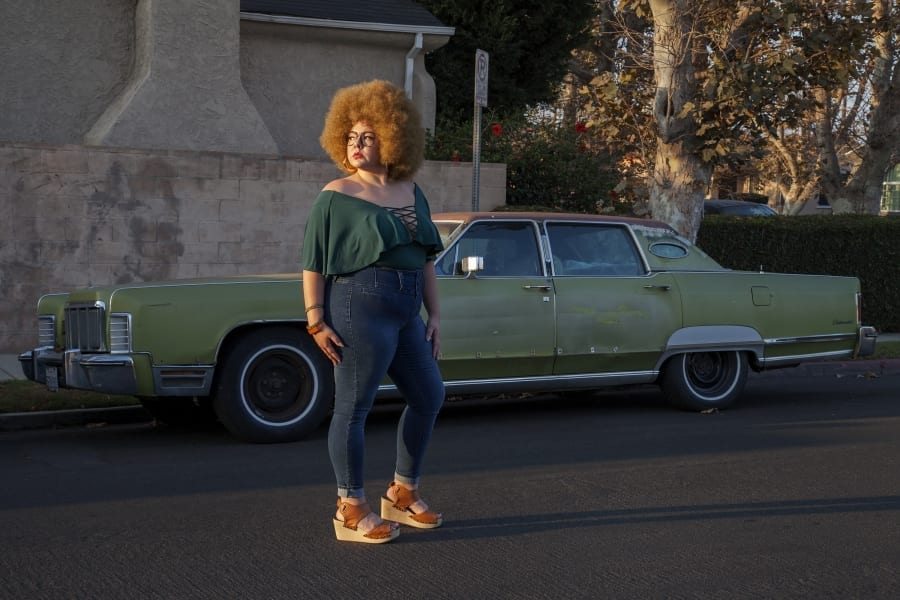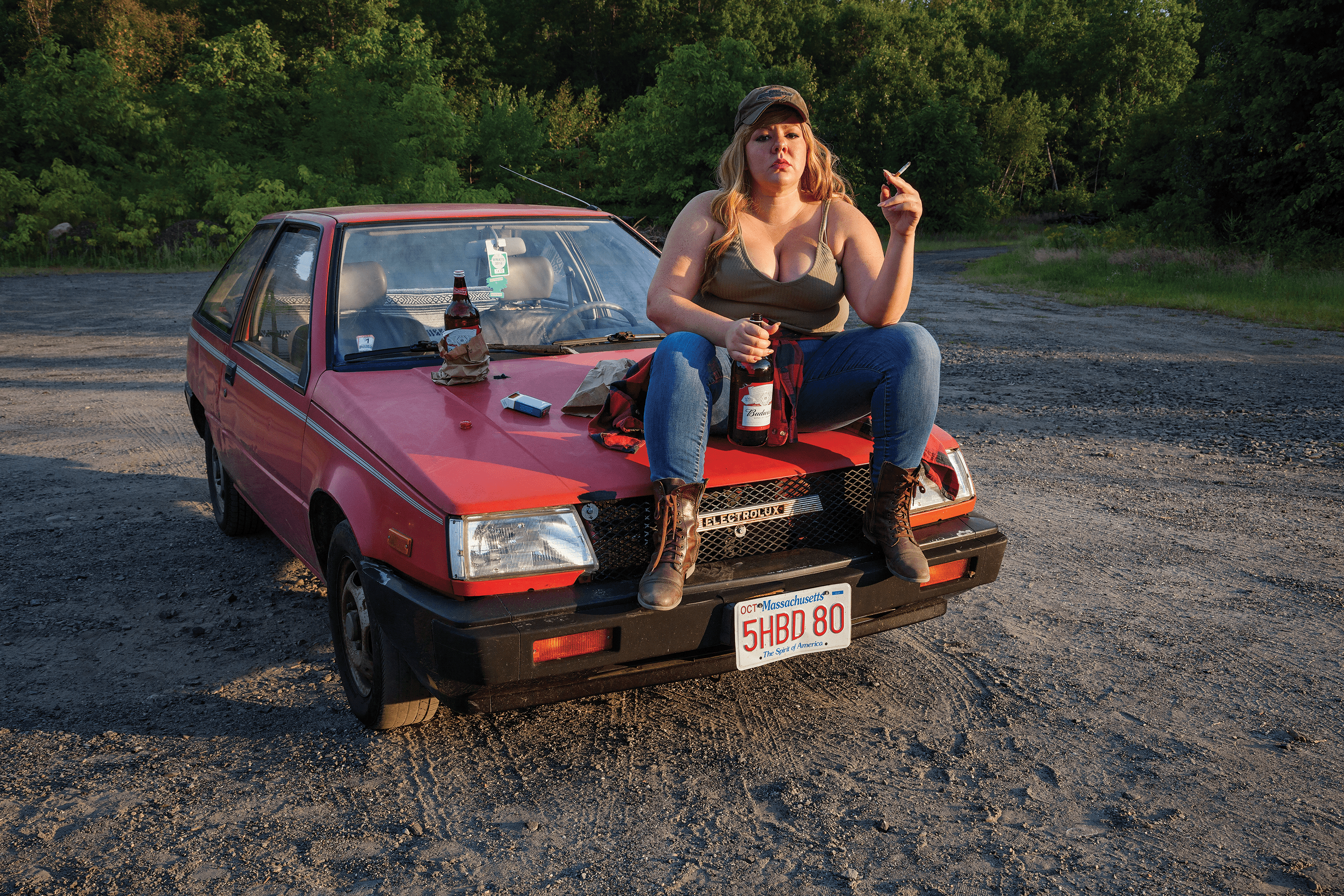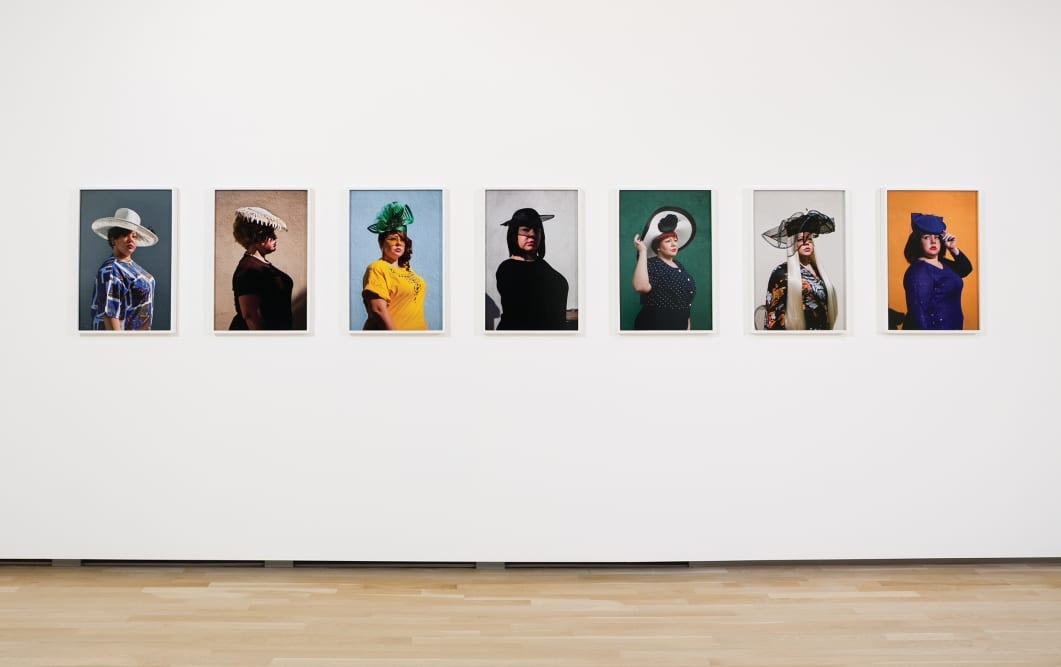Genevieve Gaignard and I have been friends for about 10 years. We’ve seen each other go through BFA programs, MFA programs, and have crossed paths both coasts as we spend our 30’s navigating the art world. Though we’ve known each other for a while now, this was the first time I was able to talk to Genevieve about her studio practice and the work that is gaining her some well-deserved recognition.
Nelson Chan (NC): Can you talk about how your creative process has been developing from graduate school till now? I’m curious about the “light bulb moment” when you felt like your work was hitting its stride. Can you talk about your creative process of combining photographs, installation, sculpture, and performance into a cohesive statement?
Genevieve Gaignard (GG): As I began applying to Yale for my second time, I started getting into making these lip-sync videos. The personas lived in the videos first. I created four different characters and decided to make them their own teen magazine poster to “promote” the video. I was going for pinup imagery. The process of making those posters segued into the idea that I could continually photograph myself in this way, as different people.

Working in a variety of mediums allows me to say what I want without the constraints of a specific tool. A photograph makes one statement, but I also like tactile moments. I want the photos to come to life with context. The assemblage works and the sculptures function like slices of my more immersive installations. They are all talking to each other; clothes from a photo might be in an installation, a book from a sculpture might be ephemera from my own childhood home. The ambiguity and fluidity is crucial.
NC: How do you feel about the idea of the “twenty-first century Selfie” being attached to your work? I’m not even sure what that means myself. Do you see a difference in a selfie and a self-portrait?
GG: Yeah, I see a difference, but I like to link the two. A selfie is a self-portrait, but a self-portrait is not necessarily a selfie. There is a prolific element to shooting my characters that emulates the process of finding the perfect shot of yourself for social media. In the case of the pictures I show, however, it’s usually not the one in which I am the most attractive, but rather the one that is the most revealing, the one that rings true to the character.
NC: A lot of people are comparing your work to Cindy Sherman right now. I can see this obvious comparison due to the fact that the both of you are using yourselves as the models in your work. However, I don’t completely agree with this comparison and I think you are quite tired of hearing this as well, correct? When I think of Cindy Sherman’s work, I think of an artist making portraits and using themselves as the model. When I see your photographs and installations, I feel as though I’m able to piece together more interesting narratives and connections to your own biography and your position in the world as a mixed-race person/artist. For me, there is much more self-reflection. If anything, I connect your work to the likes of artists like Claude Cahun and Mickalene Thomas.
GG: I’m working in a tradition of photographic self-portraiture that Cindy Sherman pioneered. However, I’m not sure that there’s much of a conversation between our practices beyond that. I would agree with you that my work is more autobiographical than hers. I like the Claude Cahun and Mickalene Thomas comparisons, though I’m not necessarily aware of them when I’m shooting pictures.
NC: Would you consider each portrait a persona? If so, do you feel like you have to embody this persona prior to photographing yourself?
GG: There’s less of a sense of method-acting as there is a constant study of people that prepares me to enter these personas and performances. I am not pinpointing one character at a time; I am rather in an ongoing absorption of material in the world around me.
NC: Can you talk about your process of location scouting for your photographs?
GG: If I’m on the East Coast, I usually have access to the homes of family and friends. When I first moved to LA, I was doing a lot of shooting in the streets since I didn’t have a network of people to rely on. Now that I’ve been around for a bit and had a few shows on the West Coast, I’m gaining access to spaces that make sense for my work.
NC: Are there elements in your photographs that are revealed to you after the image has been made and printed? I’m curious, is there further reflection or a critique of what you’ve made after its initial conception?
GG: For sure, there isn’t always a fully fleshed out idea going into a shoot. There are some happy accidents. When I do the titling as well, I end up bringing a new read into the work, forcing viewers to reconcile it with their own read. The further reflection definitely happens when I’m coming up with the titles.
NC: I love hearing that there isn’t such a complete vision before you make the pictures. It’s refreshing to know that there are still some surprises you might hope to catch. Can you give me some examples of this where the titling has initiated further reflection?
GG: Sure. In the photograph of the girl sitting on the red car gripping a forty and smoking a cigarette, I thought to myself, “Wow, I made a character that probably would have voted for Trump.” So I came up with the title Red State, Blue Plate to imply that this character has a red state of mind while acknowledging that she lives in Massachusetts according to the license plate on the car.

Another example is the photograph titled White Rain. I found this shampoo and conditioner product called “White Rain” and I thought it was strange as soon as I saw it. My mind instantly read into what that product name could imply, so I went with it. I have the character bathing in a tub of bubbles with her arms reaching out as she looks toward the light. I wanted to invoke the absurdity of a history that claims whiteness to be synonymous with greatness.
NC: This may seem like a simple question to most, but would you be able to talk about hair and how you feel about it culturally, creatively, and personally? Do you think about being a red-head? It seems like people with red hair may have more self-awareness because it is technically a genetic rarity, right? I know there are even festivals devoted to people with red hair. Hair in black culture can certainly hold more resonance than with other cultures. Chris Rock made a documentary about this in 2009 and even in Malcolm X’s autobiography, he talks at length about his own red hair and how he went from learning how to conk it to reverting back to its natural tightly curled state. Of course when writing about this, Malcolm X was critiquing the cultural and racial conformity of black Americans trying to adopt white aesthetics in the 50s and 60s.
GG: I will direct you to my Instagram handle @creativecurvyginger for that one! There are a lot of assumptions of what Blackness should look like, and emphasizing my hair’s color plays into those insufficient stereotypes. Among my siblings, my brothers all have dark hair and my red-head status added another outsider element to my daily life. People used to ask whether or not we were even related. I work with wigs in nearly every photograph, so hair is definitely something I’m interested in. If I’m wearing a straight-haired wig, I’m often presumed to be portraying a white woman. It’s one detail, and it changes everything. It’s entertaining, too, because a majority of my wigs are purchased at stores marketed for black women. Wigs operate on multiple planes. They portray different colors, textures, and hairstyles. While the first two characteristics, color and texture, have more obvious associations with race and ethnicity, the last one is a bit less clear cut, and leads into many of the discussions of cultural appropriation that I touch on in the work.
NC: On a photographic level, I can connect your work and some of your hair choices to photographs by William Eggleston — the back of the woman’s head, for examples (he also loves to photograph gingers) or Alec Soth’s picture of the woman holding a photograph of an angel. I’m also thinking about the work of Nigerian artist J.D. Okhai Ojeikere or the South African artist Zanele Muholi, where their work starts to meditate on the more cultural and ethnic implications of hair. These are the artists I immediately think about when I pull out the importance of hair in your work. Would you be able to talk about some other influences or is this a much more intuitive approach when thinking about how to incorporate hair in your work?
GG: I think it’s a bit more on the intuitive side, in the sense that I’m referencing people I see everyday, whether I’m in LA or shooting back home. I’m flattered to be constellated within such incredible artists like those you mentioned, but I’m actually more influenced by celebrities, pop culture, and social media.
NC: How do you go about using celebrity, pop culture, and social media in your process? Is there a method to how you pull from these different sources of inspiration, or do you just absorb it and see what happens?
GG: For me, it’s about absorbing it, like you said. I just take in as much as I can and then I’ll pull from that while I’m in the process of making work. But when I’m really immersed in a project, I’ll often tune out for a while. Once I’ve completed that particular work, I’ll then take time to tune back in and see what I’ve missed and what’s current. I like to give myself time to get back in touch with what’s relevant in pop culture and social media.

NC: Sub question—is there a difference between the concept of passing and conformity to you?
GG: Passing has always been a survival strategy, it’s not about assimilation or conformity to me. In my daily life, passing is less of something that I seek out and more of something that’s given to me.
NC: Your work is not only photographic, but involves quite elaborate installations and set building. Western Massachusetts, where you’re from, has a very prominent antique and tag sale culture—could it be said that this part of your work is tied to that part of your biographical geography? I remember reading about how you consider your mother a collaborator of sorts with regard to helping you source items for your installations. What’s her reaction when she steps into one of your spaces? I’m thinking back to when I saw your first installation of work at the NYC Spring/Break Art Show.
GG: Yes, I would say that the antique sourcing element of my practice is strongly rooted in a New England childhood. My mom has always been a collector of things, accumulating stuff that may have a future purpose. She a real “one man’s trash is another man’s treasure” kind of gal. To this day, I can give her a mission to find an object I have my mind set on for a particular project and trust that she will find what I need. She was a huge help in sourcing the hand mirrors for my sculpture Selfie Stick.
For me, the installations are often a reaction to the space I grew up in. There is a sense of organizing the clutter. I think it allows her to see how big of an influence she has been, and that my mind values these objects I was surrounded by to this day. She has played such a strong role in my aesthetic evolution, and I think she feels that when she spends time in my spaces.

